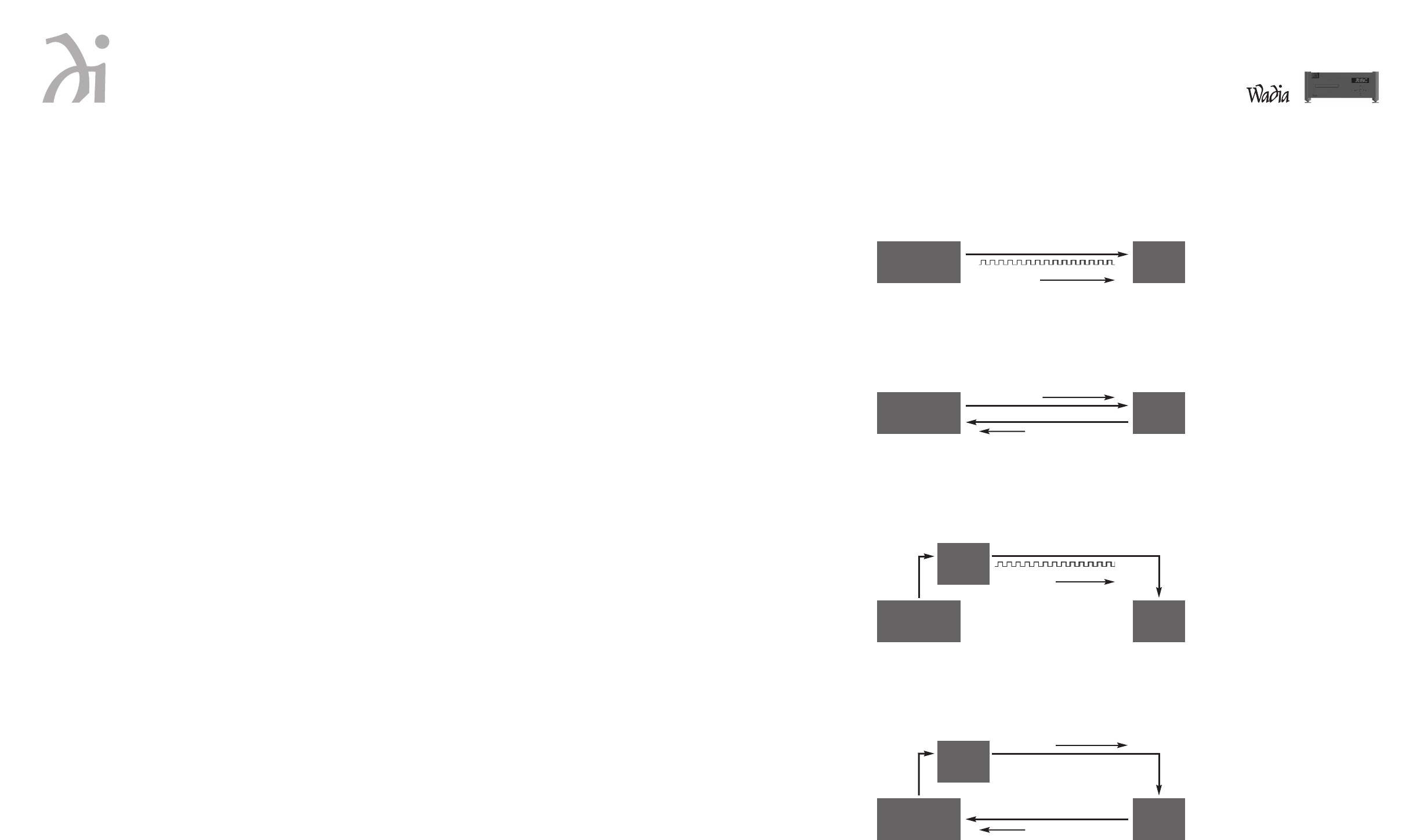
581 Disc Player
12 13
Inverting Absolute Phase
The Wadia 581 Disc Player has the ability to invert absolute phase in the digital domain. Pressing the Phase
Invert button on the remote control will cause the Wadia 581 to invert phase; pressing it again will switch the
phase back to normal. If the Wadia 581 Disc Player is in Phase Invert mode, this will be indicated on the Input
Screen of the display.
Turning Display On/Off
By pressing the Display On or Off button, the Wadia 581 Disc Player display can be turned off completely.
Mute Modes
The Wadia 581 Disc Player has two mute modes that are automatically implemented under different circumstances.
DSP-Software Mute
When the Mute button is pressed on the remote control, the Wadia 581 Disc Player’s DSP engine transmits a
stream of zero signal level samples to the DAC section, which results in zero output.
Output-Relay Mute
The Wadia 581 Disc Player has mute relay connected between the positive and negative outputs. When this
relay is engaged, it connects the positive output to the negative output, reducing the output to zero. This relay,
which produces an audible click when it engages or disengages, is not in the music signal path. The mute
relay is engaged:
•When the Wadia 581 Disc Player detects AC input level below its minimum operating range.
•Each time the Wadia 581 Disc Player power switch is turned on.
•When the volume control is set to zero AND the mute button on the remote control is pressed. When the
Wadia 581 Disc Player is in either Mute Mode, the Volume Screen will indicate this by Displaying the
word, “MUTE.”
TRACK FORWARD/REV: Pressing these buttons allows access to the previous or next track on a disc.
SEARCH/FORWARD/REV: Pressing these buttons allows fast reverse or fast forward access through a track.
Pressing the PLAY button to resumes normal playback.
STOP: Pressing this button while a disc is playing stops PLAY.
PAUSE: Pressing this button, while a disc is playing, suspends PLAY. Pressing the PLAY button or the PAUSE
button will resume play at the point where the pause button was pressed.
PLAY: After a disc has been loaded into the drawer, pressing this button plays the disc beginning with the first
track on the disc or in a sequenced program. Pressing this button while the drawer is open closes the drawer
and begins play with the first track on the disc or in a sequenced program.
Theory of Operation
Using ClockLink with an External Processor
ClockLink eliminates jitter added when the clock signal is recovered from the digital data stream. In a
non-ClockLink system, jitter is added when the clock signal is embedded in the data stream and transmitted
to the DAC. When the clock signal is recovered from the data stream (as shown below), and used to clock the
DAC output, this jitter degrades the sonic performance.
With ClockLink, the clock is not recovered from the data. Instead, the master clock is located at the DAC. This
clock signal is transmitted to the transport to keep it synchronized with the DAC. Because the recovered clock
is ignored, any jitter on that signal does not affect the sonic performance.
The Wadia 581 Disc Player with its digital inputs and outputs can be used with a digital signal processor
such as a digital equalizer. Digital processors allow the signal to be modified without adding analog noise and
distortion. However, digital processors can add jitter, as shown below, causing noticeable sonic degradation.
Using ClockLink with an external processor, the Wadia 581 Disc Player ignores the incoming clock and uses
the master oscillator at the DAC. As a result, jitter added by the external digital processor does not affect
sonic performance.
Transport DAC
Data to DAC
CD Player with ClockLink
Clock to Transport
Clock to Transport
Transport DAC
Data and Clock to DAC
Conventional CD Player
Jitter Added
Transport
Digital
Processor
DAC
Data and Clock to DAC
Conventional CD Player with an External Digital Processor
Jitter Added
Digital
Output
Digital
Input
Transport
Digital
Processor
DAC
Data to DAC
CD Player with ClockLink with an External Digital Processor
Digital
Output
Digital
Input












